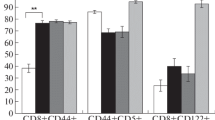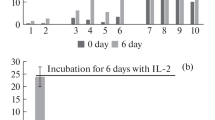Abstract
In the present study T lymphocytes isolated from a metastatic lymph node (T-LNL) of a melanoma patient have been cloned. In the attempt to verify whether T-LNL may acquire in vitro functional activities in the absence of tumour-associated antigens, they were cloned utilizing allogeneic lymphocytes as feeder cells. Nineteen clones generated from T-LNL proved to be CD4+ and, among these, five were able to kill autologous and allogeneic human melanoma cells in HLA-class-II-restricted way. On the basis of their cytokine production, these CD4+ cytolytic T-LNL clones were shown to belong to the Th0 subset and three of them expersseed the Vβ17 chain of the T cell receptor. These results suggest the presence of melanomaspecific but functionally inactive lymphocytes with T cell receptor oligoclonality in the lymph node environment. These specific T cells may acquire in vitro the capacity to kill autologous and allogeneic tumours without any induction by autologous melanoma cells.
Similar content being viewed by others
References
Anichini A, Macalli C, Mortarini R, Salvi S, Mazzocchi A, Squarcina P, Herlyn M, Parmiani G (1993) Melanoma cells and normal melanocytes share antigens recongnized by HLA-A2-restricted cytotoxic T cell clones from melanoma patients. J Exp Med 177:989
Chen Q, Hersey P (1992) MHC-restricted responses of CD8+ and CD4+ T-cell clones from regional lymph nodes of melanoma patients. Int J Cancer 51:218
Cochran AJ, Phil E, Wen DR, Hoon DS, Korn EL (1987) Zoned immune suppression of lymph nodes draining malignant melanoma: histologic and immunohistologic studies. J Natl Cancer Inst 78:299
Coffman RL, Chatelain LM, Leal CC, Varkila K (1991) Leishmania major infection in mice: a model sistem for the study of CD4+ T-cell subset differentiation. Res Immunol 142:36
Cozzolino F, Torcia M, Carossino AM, Giordani R, Selli C, Talini G, Reali E, Novelli A, Pistoia V, Ferrarini M (1987) Characterization of cells from invaded lymph node in patients with solid tumor. J Exp Med 166:303
Farzad Z, Cochran AJ, McBride WH, Gray JD, Wong V, Morton DL (1990) Lymphocyte subset alterations in nodes regional to human melanoma. Cancer Res 50:3585
Fleischer B (1984) Acquisition of specific cytotoxic activity by human T4+ T lymphocytes in culture. Nature 308:365
Hoon DS, Bowker RJ, Cochran AJ (1987) Supperssor cell activity in melanoma-draining lymph node. Cancer Res 47:1529
Hoon DS, Korn EL, Cochran AJ (1987) Variations in functional immunocompetence of individual tumor-draining lymph nodes in humans. Cancer Res 47:1740
Hoon D, Banez M, Okun E, Morton D, Irie R (1991) Modulation of human melanoma cells by interleukin-4 and in combination with gamma-interferon of alfa-tumor necrosis factor. Cancer Res 51:2002
Indiveri F, Pierri I, Rogna S, Poggi A, Romano R, Tavano A, Ratto G, Motta G, Ferrone S (1986) Abnormalities of T cells isolated from mediastinal lymph nodes and peripheral blood of patients with lung carcinoma: deficit in PHA-induced expression of HLA class II antigens and in autologous mixed lymphocyte reactions. Cancer Immunol Immunother 22:232
Joannides CG, Whiteside T (1993) T cell recognition of human tumors: implications for molecular immunotherapy of cancer. Clin Immunol Immunopathol 66:91
Le May L, Kan-Mitchell J, Goedegebuure P, Harel W, Mitchell MS (1993) Detection of melanoma-reactive CD4+ HLA-class I-restricted cytotoxic T cell clones with long-term assay and pretreatment of targets with interferon-gamma. Cancer Immunol Immunother 37:187
Lu C, Vickers MF, Kerbel RS (1992) Interleukin 6: a fibroblast derived growth inhibitor of human melanoma cells from early but not advanced stages of tumor progression. Proc Natl Acad Sci USA 89:9215
Mastrangelo MJ, Baker AR, Katz HR (1985) Cutaneous melanoma. In: De Vita VT Jr, Hellman S, Rosenberg SA (eds) Cancer principles and practice of oncology. Lippincott, Philadelphia,p 1371
Mckisic MD, Sant AJ, Fitch FW (1991) Some cloned murine CD4+ T cells recongnize H-2Ld class I MHC determinants directly. Other cloned CD4+T cells recognize H-2Ld class I MHC determinants in the context of class II MHC molecules. J Immunol 147:2868
Miescher S, Witheside TL, Carrel S, von Fliedner V (1986) Functional properties of tumor-infiltrating and blood lymphocytes in patients with solid tumors: effects of tumor cells and their supernatants on proliferative response of lymphocytes. J Immunol 136:1889
Miescher S, Stoeck M, Qiao L, Barras C, Barrelet L, von Fliedner V (1988) Proliferative and cytolitic potentials of purified human tumor-infiltrating lymphocytes: impaired response to mitogen-driven stimulation despite T-cell receptor. Int J Cancer 42:659
Miescher S, Stoeck M, Whiteside TL, Leyvraz S, Ruzicka J, Schindler AM, Givel JC, Mosimann F, von Fliedner V (1988) Altered activation pathways in T lymphocytes infiltrating human solid tumor. Transplant Proc 20:344
Moretta A, Pantaleo G, Moretta L, Cerottini JC, Mingari C (1983) Direct demonstration of the clonogenic potenital of every human peripheral blood T cell. Clonal analysis of HLA-DR expression and cytolytic activity. J Exp Med 157:743
Mosmann TR (1991) Cytokine secretion phenotype of TH cells: how many subsets, how much regulation? Res Immunol 142:9
Mukherji B, Guha A, Chakraborty NG, Sivanandham M, Nashed AL, Sporn JR, Ergin MT (1989) Clonal analysis of cytotoxic and regulatory T cell responses against human melanoma. J Exp Med 169:1961
Mukherji B, Chakraborty NG, Sivanandham M (1990) T cell clones that react against autologous human tumors. Immunol Rev 116:33
Nitta T, Oksenberg JR, Rao NA, Steinman L (1990) Predominant expression of T-cell receptor V-alpha 7 in tumor infiltrating lymphocytes of uveal melanoma. Science 249:672
Ottenhoff TH, Mutis T (1990) Specific killing of cytotoxicity T cells and antigen-presenting cells by CD4+ cytotoxic T cell clones. A novel potentially immunoregulatory T-cell interaction in man. J Exp Med 171:2011
Parmiani G (1993) Tumor immunity as autoimmunity: tumor antigens include normal self proteins which stimulate anergic peripheral T cells. Immunol Today 14:536
Patel SS, Duby AD, Thiele DL, Lipsky PE (1988) Phenotypic and functional characterization of human T cell clone. J Immunol 141:3726
Puisieux I, Even J, Pannetier C, Joterau F, Favrot M, Kourilsky P (1994) Oligoclonality of tumor-infiltrating lymphocytes from human melanomas. J Immunol 153:2807
Schoof DD, Terashima Y, People GE, Goedegebuure PS, Andrews VR, Richie JP, Eberlein TJ (1993) CD4+ T cell clones isolated from human renal cell carcinoma posses the functional characteristic of Th2 helper cells. Cell Immunol 150:114
Sensi M, Castelli C, Salvi S, Mazzocchi A, Mortarini R, Nicolini G, Anichini A, Parmiani G (1993) Expansion of major histocompatibility complex-restricted antimelanoma cytotoxic T-cell lymphocyte clones with identical T-cell receptor from tumor-infiltrating lymphocyte. J Immunother 12:207
Shilyansky J, Nishimura MI, Yanelli JR, Kawakami Y, Jacknin LS, Charmley P, Rosenberg SA (1994) T-cell receptor usage by melanoma-specific clonal and highly oligoclonal tumor-infiltrating lymphocyte lines. Proc Natl Acad Sci USA 91:2829
Shimizu Y, Weidmann E, Iwatsuki S, Herberman RB, Whiteside TL (1991) Characterization of human autotumor-reactive T-cell clones obtained from tumor-infiltrating lymphocytes in liver metastasis of gastric carcinoma. Cancer Res 51:6153
Topalian L, Solomon D, Rosenberg SA (1989) Tumor-specific cytolysis by lymphocytes infiltrating human melanomas. J Immunol 142:3714
Whiteside T, Herberman RG (1990) Characteristics of natural killer cells and lymphokine-activated killer cells. Their role in the biology and treatment of human cancer. Immunol Allergy Clin North Am 10:667
Whiteside TL, Jost LM, Herberman RB (1992) Tumor-infiltrating lymphocytes. Potential and limitations to their use for cancer therapy. Crit Rev Oncol Hematol 12:24
Wong JT, Pinto CE, Gifford JD, Kurnick JT, Kradin RL (1989) Characterization of the CD4+ and CD8+ tumor infiltrating lymphocytes propagated with bispecific monoclonal antibodies. J Immunol 143:3404
Author information
Authors and Affiliations
Rights and permissions
About this article
Cite this article
Imro, M.A., Castagneto, C., Bosco, O. et al. CD4+ Th0 cell clones, isolated from a metastatic lymph node of a melanoma patient, possess cytolytic function. Cancer Immunol Immunother 41, 210–216 (1995). https://doi.org/10.1007/BF01516995
Received:
Accepted:
Issue Date:
DOI: https://doi.org/10.1007/BF01516995




